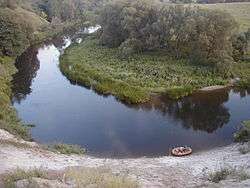Mayakovskoye
Mayakovskoye (Russian: Маяко́вское), previously known in German as Nemmersdorf (Lithuanian: Nemirkiemis), is a rural locality (a settlement) in Gusevsky District of Kaliningrad Oblast, Russia, located on the banks of the Angrapa River.

Until 1945, Nemmersdorf was a part of German East Prussia. It became known during World War II on October 22, 1944 as the site of the first Soviet war crime on German territory against German women, French and Belgian POWs—the Nemmersdorf massacre.
History
The first documented mention of Nemmersdorf was in 1515 in a decree of the Insterburg Central Office.[1] By 1910, it counted a total of 484 residents, further increasing to 637 by 1939.[2] Between 1874 and 1945, Nemmersdorf was the principal urban locality in Gumbinnen administrative district within the county of Nemmersdorf-Gumbinnen in East Prussia. The municipality included thirteen rural communities.[3]
On October 22, 1944, Nemmersdorf was the scene of a massacre perpetrated by the Soviet soldiers against German civilians and French and Belgian noncombatants. Determining the facts has aroused controversy.[4]
Following World War II, Nemmersdorf came under the Soviet administration and was given its present name in 1946. The native German population who survived the massacre either fled or were formally expelled.
Religion
The Nemmersdorf stone church was constructed on the orders of Albert, Duke of Prussia, but it was completed after his death, in 1589. It was a simple rectangular bay near the Angerapp River, with sacristy facing east. In 1769, the church was renovated with an altar from the workshop of Isaac of Riga.[5]
Despite the damage in 1944, the church has survived two world wars. The nave has been preserved, now with a flat ceiling, but the tower is missing. After 1945, the church was used for other purposes and as a business building. In the early 1960s, it was rebuilt and now serves as a cultural center and library.
Until 1945, Nemmersdorf was predominantly Protestant with thirty Protestant clergy.[6] During the Soviet period, church life was discouraged. Only in the 1990s was the new Kaliningrad Oblast Evangelical Church established. The Parish belongs to the Provost's Kaliningrad Evangelical Lutheran Church in European Russia.[7]
References
Notes
- Kreisgemeinschaft Gumbinnen. Nemmersdorf mit weiteren Gütern (in German)
- Verwaltungsgeschichte.de Landkreis Gumbinnen (in German)
- Territorial.de. Amtsbezirk Nemmersdorf (in German)
- Fisch, Bernhard. Nemmersdorf, Oktober 1944: Was in Ostpreußen tatsächlich geschah. Berlin: 1997. ISBN 3-932180-26-7
- http://www.ostpreussen.net/index.php?seite_id=12&kreis=05&stadt=03&bericht=02
- Friedwald Moeller, Altpreußisches evangelisches Pfarrerbuch von der Reformation bis zur Vertreibung im Jahre 1945, Hamburg, 1968, Seite 100
- "Archived copy". Archived from the original on August 29, 2011. Retrieved October 19, 2011.CS1 maint: archived copy as title (link)
Sources
- Brandenburg, Christel Weiss and Dan Laing. Ruined by the Reich: Memoir of an East Prussian Family, 1916-1945. McFarland & Company. ISBN 0-7864-1615-7
- Dönhoff, Marion. Namen die keiner mehr nennt. Munich: Deutscher Taschenbücher Verlag, 1962.
- Fisch, Bernhard. Nemmersdorf, Oktober 1944: Was in Ostpreußen tatsächlich geschah. Berlin: 1997. ISBN 3-932180-26-7
- Samuel, Wolfgang. "War on the Ground", in The War of Our Childhood: Memories of World War II, University Press of Mississippi. ISBN 1-57806-482-1
- Thorwald, Jürgen.Wielka ucieczka (Große Flucht). Kraków: Wydawnictwo Literackie, 1998. ISBN 83-08-02890-X